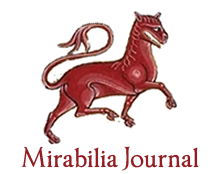About he name of St. Mary of Blaquerna: some questions and answers
Júlia BUTINYÀ
Original title: Sobre el nom de santa Maria de Blaquerna: algunes preguntes i respostes
Published in Idea and image of royal power of the monarchies in Ancient and Medieval World
Keywords: Crown of Aragon, Mariology, Middle Ages, Ramon Llull.
About the name of the Virgin who is identified with the protagonist of the first novel of Ramon Llull, Romanç d’Evast e Blaquerna, several contributions have been made lately; here we add some new and formulate some questions. Because to the hypothesis established about the image as coming from the church of the palace of Constantinople, I added that of Corfu as its original place. Now, the fact of having found two churches with the same name in the area of the Ionian Sea enhances the value and influence of the primitive image, as well as its original location in Corfu.
Benedicta in mulieribus. The Virgin Mary as a paradigm of women in the patristic tradition and its possible reflection in Spanish Gothic painting
José María SALVADOR GONZÁLEZ
Original title: Benedicta in mulieribus. La Virgen María como paradigma de la mujer en la tradición patrística y su posible reflejo en la pintura gótica española
Published in Mulier aut Femina. Idealism or reality of women in the Middle Ages
Keywords: Iconography, Mariology, Paradigm, Patristics, Spanish Gothic painting., Theology, Women.
From the first centuries of the Christian era the Virgin Mary became in respect of the believers a sublime and inimitable model of human, moral and spiritual virtues. This fact has been staged by researchers on Marian iconography as a self-evident axiom, which need not be explained or justified documentarily. Going against this uncritical stance, this paper aims to explain, through a lot of theological and patristic citations, three fundamental aspects or attributes, in which, among many others, the paradigmatic character of Mary becomes real: her supereminence in comparison with the other women, her supereminence in comparison with the other creatures, including angels and saints, and her intercession before God on behalf of human beings. We complement our study by a comparative analysis through which we attempt to relate these patristic and theological sources with some Spanish Gothic paintings in which the three mentioned aspects of the analyzed Marian doctrine could be reflected in some way.
Mariology, Queenship and Power in Isabel de Villena. A Female Political Theory of the 15th Century
María del Mar GRAÑA CID
Original title: Mariología, reginalidad y poder en Isabel de Villena. Una teoría política femenina del siglo XV
Published in Isabel de Villena (1430-1490)
Keywords: Female Humanism, Isabel the Catholic, Mariology, Queenship, Querelle des femmes, Virtues.
Isabel de Villena, author of Humanism, offers a female paradigm of government in her Vita Christi: The Virgin Mary as queen and as pope. Through queenship, she formulates a new political ethic that she presents as a model to power male holders. Its study confirms the participation of the author in the “Querelle of Femmes” and show coincidences with contemporary courts of queens like Isabel I.
St. Bonaventure’s aesthetic ideas as possible doctrinal source of Trecento Italian iconography
José María SALVADOR GONZÁLEZ
Original title: Ideas estéticas de San Buenaventura como posible fuente doctrinal de la iconografía del Trecento italiano
Published in Art, Criticism and Mysticism
Keywords: Aesthetics, Iconography, Italian painting, Mariology, Patristics. Medieval Philosophy, St. Bonaventure, Trecento.
This paper attempts to highlight the influence that the primary Aesthetics designed by St. Bonaventure could have had on some paintings of the Italian Trecento. Therefore, the work is divided into two parts essentially linked. Firstly it analyzes in detail the first two levels (of the six proposed by the saint. plus a seventh of pure ecstasy), by which man can and must ascend from the world to contemplate God: on those two initial levels, linked to the sensory knowledge, man uses his sensitivity to appreciate the material things of this created world as footprints and traces of their Creator. In the second part several paintings by Giotto, Simnone Martini, Pietro Lorenzetti, Ambrogio Lorenzetti, Agnolo Gaddi and Taddeo Gaddi are analyzed, in order to see if one can perceive in them some influence of the initial phase of the Aesthetics of Bonaventure, that implies a remarkable enhancement of the physical world and the senses by which we perceive it with full cognitive validity.
The Annunciation in Fra Filippo Lippi: interpreting some symbolic variants
José María SALVADOR GONZÁLEZ
Original title: The Annunciation in Fra Filippo Lippi: interpreting some symbolic variants
Published in
Keywords: Annunciation, Christianity, Fra Filippo Lippi, Mariology, Medieval iconography, Patristics.
The doctrine of Jacob of Serugh on conceptio per aurem as a possible literary source in medieval iconography of The Annunciation
José María SALVADOR GONZÁLEZ
Original title: La doctrina de Jacob de Sarug sobre la conceptio per aurem como posible fuente literaria en la iconografía medieval de La Anunciación
Published in
Keywords: Conceptio per aurem, Iconography, Jacob of Serugh, Mariology, Medieval Art, Patristics, The Annunciation, Theology.
This paper focuses the attention on the possible influence that the thinking of the Syriac theologian Jacob of Serugh on conceptio per aurem might have had on late medieval representations of the Annunciation. Therefore, after explaining the doctrine of this Oriental thinker by explaining many passages of his writings, ten pictorial images of this Marian theme in which you could glimpse such influence are analyzed. While underlining the prestige of this great writer of Serugh and the wide dissemination of his works during the Middle Ages, the author also emphasizes that the interpretation given in this paper is only a mere conjecture that, even if it looks plausible, is susceptible of enrichment, correction and even rejection, if reliable documentary evidence so require.






















































































